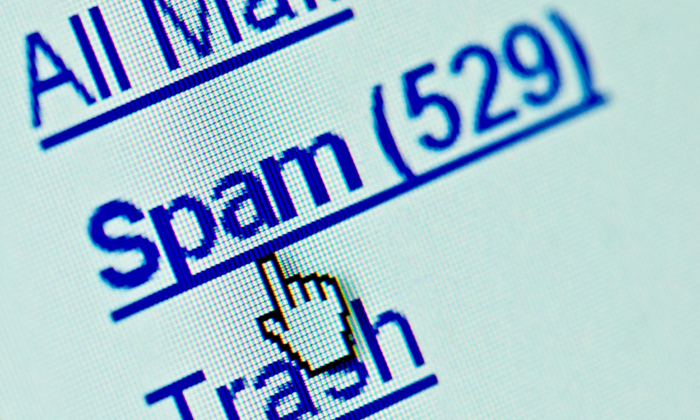Why Do I Need to Learn the Difference Between Phishing and Spamming? How To Recognize Them?
by Robert Fox
Are you still unaware of phishing and spamming? Since the origin of the email era, phishing and spamming have been two of the most frequent types of online crime. Phishing and spamming are unethical, immoral, and illegal. The purpose is to commit fraud, typically for financial gain. In some circumstances, the categories of fraud committed include identity theft, hacking, and scamming. Find out more about this cybersecurity issue and you will be able to avoid being a victim and help keep your network and customers secure.
Contents

Is Phishing the Same as Spamming?

Many people think that spam and phishing are the same things, but they aren't the same. Let just discuss in detail to know about spam and phishing.
Phishing
Phishing is a type of cyberattack. It's deceptive and tries to steal your personal data from you, your account passwords, or even tries to infect devices from malware. It occurs when an attacker sends you a fraudulent message that appears to come from a reputable agency. It is usually done through emails. Phishing is a type of cyberattack that uses email as a weapon. The attacker uses credentials to steal money from the victim. Examples of a Phishing emails include fake invoice scams, google document scams, Dropbox scams, etc.
Types of Phishing

There are many types of Phishing, some are given as follows:
· Spear Phishing
· Normal phishing
· Whaling
· Clone Phishing
· BEC Phishing
Spear Phishing
Spear Phishing is a customized cyberattack on a specific individual and a company, that is known and trusted by a recipient. A spear-phishing typically includes an email and attachment. The email consists of information specific to the individual, the name, and the status of the company.
Normal Phishing
In normal phishing, hackers send out emails in large batches to attack anyone they can. The attacker will impersonate a reputable company and attempt to steal individual login credentials.
Whaling
It's a type of phishing that is specially designed to target wealthy, powerful, or prominent individuals. A victim within a company within a company e.g. CEO, executive, or another high-profile target. For individuals, this includes unauthorized purchases and stealing of funds.
Clone Phishing
A hacker clones a legitimate email message that is sent from a reputable organization or business to attack the victim. It's easy to be a victim of clone phishing. It appears to come from the contacts or colleagues and looks like a resend of a previous message.
BEC Phishing
Business Email Compromise (BEC) is a type of phishing, in which a hacker targets a business that conducts wire transfers. It belongs to the most damaging online crimes. The attacker will most often use the owner's email account to trick an employee to share sensitive data and money transfer details.
How Phishing Works?

1. Hackers search the Individual
2. Hackers sends a customized email
3. Victim opens malware containing email
4. Hackers get an access to steal your personal data through Network
Signs To Help You Identify the Phishing
· Success of phishing often depends on how well the email bears a resemblance to official company
· Look for generic greetings
· Misspelling in the links
· If you don't see "https," in the link hit delete.
· Reputable companies hardly send the same message twice.
· Should check domain names
· Workers should also be addressed to contact the executive director.
How To Protect Your Device against Phishing
· Install security software
· Protect your account by multi-factor authentical
· Backup your data
Spam

Spam is the same as junk mail. It is typically unsolicited advertisements for things that are sent over the internet to many users like saving for insurance plans, home security allowance, food offers, or even personal loans. They are the bulk messages that reach millions of people across the globe. Many people are unaware of the real damage caused by spam, especially in the environment of organizations and companies.
Types of Spam

Spam can be classified into many types; some common types are listed below:
· Email spam
· Negative SEO spam
· Trackback Spam
· Spiders, Bots and DDoS Attack
Email Spam

If you receive an email warning you about a virus on your electronic device, then it's probably a malware warning spam email. When you click a link or any image in the spam messages, it may infect your device. An Email virus is also known as unwanted or unsolicited emails that usually spread the virus through links.
Common email spoofing spam messages include:
- An application for payment of an invoice
- A request to reset your password
- Verification of purchases
- Request for billing information
Negative SEO Spam
It's a form of malicious spam designed to change the ranking by pushing down the competitive website. It is commonly called "Black Hat SEO"
Negative Hacking can be attacked in different ways:
· Hack your website
· Copy your content and share it all over the world
· Create spam links on your website
· Create your Fake profile and run your business online
Trackback Spam

A type of spam, in which spammer produces automated scripts to send millions of trackbacks to websites across the world. It became a serious issue for the website owner. A common method used to include a malicious script by attachment of a similar type of file. If the attachment is opened, the script runs and retrieves the malware.
Spiders, Bots and DDoS Attack
Malware bots can be automated to break into your account to get access to your personal documents. A bot can be seen as a warning sign, if you don't click on the relevant link your device will catch the virus. Malware bots create issues for the organization. Their potential to obtain sensitive data such as passwords and bank details. Hackers spread bad bots in a botnet (number of networking contains devices, each running one or more bots) Botnets can grow and can infect more devices. Malware bots cannot be noticed easily, hidden in the computer files. DDoS attacks online shops to list their goods and add them to the cart by not completing the transaction.
How do Spam Work?

Social engineering is the art of handling people so they can give up secret information. Spam is the popular form of social engineering in which a scammer sends out fake forms of communication mainly electronically that resemble a trusted company that an individual may do business with. Spam can also be sent in bulk volume by botnets, which are networks of infected computers. The main purpose is to trick the recipient into giving personal information. Sometimes malware is also installed on computers.
Signs To Help You Identify the Spam
· Spelling and grammatical errors
· Request for personal data
· Links that do not refer to the organization
· Forms within emails to be filled
· Informal language
How To Protect Your Devices against Spam?
· Use of Antivirus Software
· Use a Strong password
· Avoid untrusted ads and website
· Install a firewall
· Use bot manager
· Built-in spam filter
Comparison of Spam vs Phishing

| SPAM | PHISHING |
| Unsolicited bulk email | Fraudulent emails |
| Same as Junk mail | Type of cyberattack |
| Utilize commercial contents | Utilize social engineering techniques |
| Ignored | Urgent action |
| Bulk of emails | Not just limited to emails |
| Bulk and unavoidable | Dangerous and Sensitive |
| Waste of time | Persuade people to give information |
| Irrelevant stuff | Claim to be from a trustful source |
How To Report Spam and Phishing ?

When messages type it through to your inbox you can report them. This is true for text messages and spam calls. Many carriers give you the authority to report spam. You can choose to block the sender, often in the same step as reporting the message. Reporting spams help your email provider or phone service carrier at detecting spam. Email spam filters hook many of these types of messages, and phone carriers often notify you of a "spam risk". Whether via email, text, phone, or social media, you want to be able to recognize them and avoid these threats.
If you get a spam email, forward it to the Anti-Phishing Group at reportphishing@apwg.org
If you get a phishing message, you should report it by using a report Phishing Button in Outlook.
If you suspect a web site or an app is spreading spam or phishing, you can report the search engines. An example here
 |
 |
 |
 |

About Robert Fox
Rob Fox is a former hydro worker who used to teach self defence in Miami for 10 years. He's currently enjoying his retirement, playing cribbage and golf with his buddies, locksmithing and home security in his spare time. Rob is an avid reader, and has even written a few books on the subject of self defence.
Thoughts on "Why Do I Need to Learn the Difference Between Phishing and Spamming? How To Recognize Them?"
 |
 |
 |
 |
Check These Out
You can Get FREE Gifts. Furthermore, Free Items here. Disable Ad Blocker to receive them all.
Once done, hit anything below
 |
 |
 |
 |